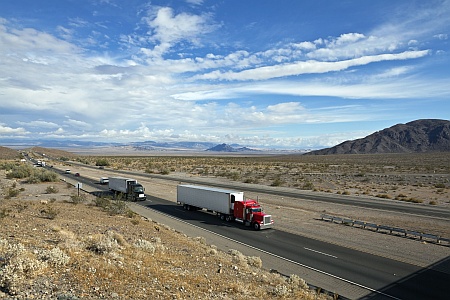NTSB calls for additional safety measures
The National Transportation Safety Board (NTSB) is calling for safety changes in tractor-trailer design and mandating rear cameras in light vehicles by 2018.
The NTSB has recommended changes in design standards to improve truck drivers’ visibility of other vehicles and pedestrians and to improve the side and rear under ride protection systems on both tractors and trailers.
The recommendations to the National Highway Traffic Safety Administration (NHTSA) also seek various improvements in safety data related specifically to trailers. NTSB said its recommendations stem from a 2013 NTSB safety study on single-unit trucks and other research that identified issues that apply to tractor-trailers as well.
“Millions of large trucks travel our roadways every day, transporting goods and keeping the American economy moving,” said NTSB Chairman Deborah A.P. Hersman. “But research shows that eliminating blind spots and underride events would reduce fatalities and injuries involving other road users.”
Like large single-unit trucks, tractor-trailers may have blind spots that can reduce the ability of drivers to see other vehicles and road users, Hersman said, adding that researchers found that limited field of view can increase the risk of death or injury among passenger vehicle occupants, pedestrians, bicyclists, and motorcyclists when drivers of tractor-trailers change lanes, make turns, go straight, or back up.
Collisions with the sides of tractor-trailers result in about 500 deaths each year and that many of these deaths involved side underride. Researchers also found that current trailer rear underride guard standards are outdated. The recommendations call on NHTSA to require that both newly manufactured truck-tractors and trailers be equipped with side underride protection systems, and that revisions be made to improve trailer rear underride guard standards to better protect passenger vehicle occupants from fatalities and serious injuries.
NTSB is also recommending that NHTSA add information on trailer model year and trailer vehicle identification numbers to its national database of fatal crashes and encourage states to add trailer information to their crash databases.
NTSB is recommending the following:
- Require that newly manufactured truck-tractors with gross vehicle weight ratings over 26,000 lbs. be equipped with visibility enhancement systems to improve the ability of drivers of tractor-trailers to detect passenger vehicles and vulnerable road users;
- Require that newly manufactured trailers with gross vehicle weight ratings over 10,000 lbs. be equipped with side underride protection systems;
- Require that newly manufactured truck-tractors with gross vehicle weight ratings over 26,000 lbs. be equipped with side underride protection systems;
- Revise requirements for rear under ride protection systems for newly manufactured trailers with gross vehicle weight ratings over 10,000 lbs. to ensure that they provide adequate protection of passenger vehicle occupants from fatalities and serious injuries resulting from full-width and offset trailer rear impacts;
- Add trailer vehicle identification number and trailer model year to the Fatality Analysis Reporting System database for trailers with gross vehicle weight ratings over 10,000 lbs.;
- Work with the Model Minimum Uniform Crash Criteria expert panel to modify the data element titled “Motor Vehicle License Number” to include the trailer license plate number in the next edition of the Model Minimum Uniform Crash Criteria Guideline; and
- Work with the Model Minimum Uniform Crash Criteria expert panel to modify the data element titled “Vehicle Identification Number” to include the trailer vehicle identification number in the next edition of the Model Minimum Uniform Crash Criteria Guideline.
For light vehicles (under 10,000 lbs.), NHTSA has issued a final rule requiring rear camera system technology in all new light vehicles – including trucks and buses – manufactured on or after May 1, 2018.
The agency added that the rear camera system’s “field of view” must include a 10-foot by 20-foot zone directly behind the vehicle and must also meet other requirements including image size, linger time, response time, durability, and deactivation protocols.
“Rear visibility requirements will save lives, and will save many families from the heartache suffered after these tragic incidents occur,” said NHTSA Acting Administrator David Friedman. “We’re already recommending this kind of life-saving technology through NCAP and encouraging consumers to consider it when buying cars today.”
According to NHTSA’s research, on average, there are 210 fatalities and 15,000 injuries per year caused by “back-over” crashes and the agency has found that children under five years old account for 31 percent of back-over fatalities each year, with adults 70 years of age and older accounting for 26 percent.
NHTSA pointed out that many vehicle OEMs are already installing rear visibility technology on their own, due to consumer demand. Including vehicles that already have such systems installed; the agency expects that 58 to 69 lives will be saved each year once the entire on-road light vehicle fleet is equipped with rear camera technology outlined in its final rule.






